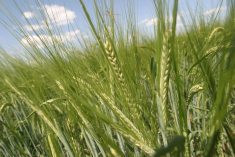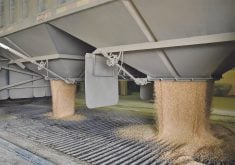‘Significantly more’ reports of fusarium head blight seen in Sask. cereal crops this season; Man. also has problem areas
Glacier FarmMedia – Fusarium head blight, a persistent threat to cereal crops across the Prairies, is making a stronger-than-usual appearance this season, but the severity and location varies.
Compared to previous years, said Alireza Akhavan, a provincial plant disease specialist in Saskatchewan, she has received “significantly more” reports of fusarium head blight in cereal crops this season.
“There (was) spraying in many regions against fusarium head blight at the provincial level at this time,” Akhavan said in an e-mail.
Read Also

New coal mine proposal met with old concerns
A smaller version of the previously rejected Grassy Mountain coal mine project in Crowsnest Pass is back on the table, and the Livingstone Landowners Group continues to voice concerns about the environmental risks.
In Manitoba, fusarium levels were more of a mixed bag, according to Manitoba Agriculture. While some cereal growers were dealing with higher levels, others reported little to no trouble with the fungal disease.
The provincial crop report released Sept. 3 said some producers in central Manitoba reported cereals were downgraded to No. 2.
“We did see fusarium throughout the province, and the actual incidence of fusarium — the amount of fusarium that we saw in a field — ranged from zero, some fields had no fusarium, upwards of fairly high levels of fusarium,” said Anne Kirk, cereals specialist with Manitoba Agriculture.
It’s important not to confuse incident with severity, Kirk cautioned. While recent surveys identified some fusarium instances, usually the severity in those cases was low, with only one spikelet on each spike showing fusarium-infected kernels.
Infected kernels are lighter and can often blow out the back of combines during harvesting, making them harder to discover.
However, most grain elevators in Manitoba are reporting that they haven’t seen significant fusarium issues in initial samples, and downgrades are few and far between.
According to Jeremy Pullinger, operator at the Delmar Commodities elevator in Gladstone, Man., a handful of samples have had a fusarium problem, just like last year.
Ryan McKnight at the Linear Grain elevator in Carman, Man., said he’s noticed more fusarium in spring wheat than in other years, which has led to some declines in grade, but noted that it’s not happening often.
“We are hearing a little bit about some higher (fusarium levels) found in barley, but … we haven’t had any real problems so far in the Carman area,” he said.
It’s too soon in Alberta to determine fusarium head blight levels in grain, said Harley Groeneveld, a senior marketing and communications specialist with Alberta Grains. More information will be available at the end of the month, Groeneveld said.
Fusarium was first discovered on the Prairies in Manitoba in 1923 but wasn’t a cause for concern until the 1980s, according to Saskatchewan Agriculture’s website.
Manitoba saw its first major outbreak in 1993, at the same time producers in Saskatchewan saw the disease near the Manitoba border. Since 2001, fusarium has become more troublesome across the Prairies and in southern Alberta in particular.
A more comprehensive picture of fusarium severity will emerge in October, when the province publishes its crop disease surveys, Kirk said. She and other specialists have been collecting samples and investigating disease across Manitoba.
More data will also be available in quality reports from the Canadian Grain Commission.


















